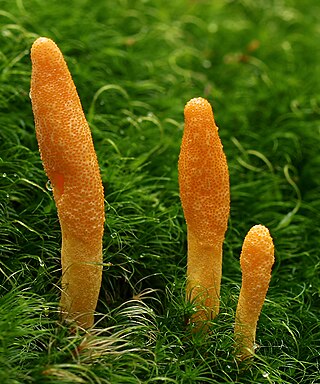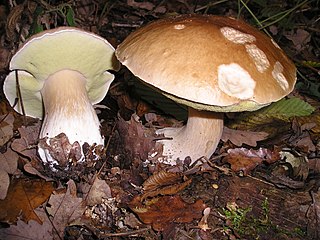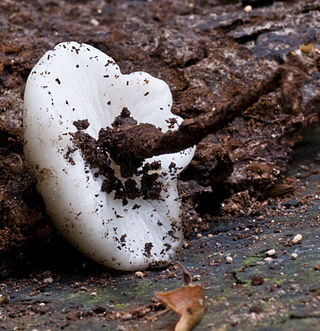Related Research Articles

Cordyceps is a genus of ascomycete fungi that includes about 600 worldwide species. Diverse variants of cordyceps have had more than 1,500 years of use in Chinese medicine. Most Cordyceps species are endoparasitoids, parasitic mainly on insects and other arthropods ; a few are parasitic on other fungi.

The Boletaceae are a family of mushroom-forming fungi, primarily characterised by small pores on the spore-bearing hymenial surface, instead of gills as are found in most agarics. Nearly as widely distributed as the agarics, the family is renowned for hosting some prime edible species highly sought after by mushroom hunters worldwide, such as the cep or king bolete . A number of rare or threatened species are also present in the family, that have become the focus of increasing conservation concerns. As a whole, the typical members of the family are commonly known as boletes.

Eurotiomycetes is a large class of ascomycetes with cleistothecial ascocarps within the subphylum Pezizomycotina, currently containing around 3810 species according to the Catalogue of Life. It is the third largest lichenized class, with more than 1200 lichen species that are mostly bitunicate in the formation of asci. It contains most of the fungi previously known morphologically as "Plectomycetes".

The Fungi of Australia form an enormous and phenomenally diverse group, a huge range of freshwater, marine and terrestrial habitats with many ecological roles, for example as saprobes, parasites and mutualistic symbionts of algae, animals and plants, and as agents of biodeterioration. Where plants produce, and animals consume, the fungi recycle, and as such they ensure the sustainability of ecosystems.
Stereosandra is a genus of leafless orchids native to Southeast Asia, the range extending north to Yunnan, Taiwan and the Ryukyu Islands, and also eastward to New Guinea, the Solomon Islands and Samoa. These are myco-heterotrophic orchids, lacking chlorophyll, obtaining nutrients from fungi in the soil instead.

Thecostele is a monotypic genus of orchids and of subtribe Cymbidiinae. The only species in the genus is Thecostele alata, first described as Cymbidium alatum by the Scottish botanist William Roxburgh in 1832. It was transferred to the genus Thecostele in 1874 by the English botanist Charles Samuel Pollock Parish and the German botanist Heinrich Gustav Reichenbach. It is native to tropical Asia and is found in northeastern India, Bangladesh, Myanmar, Thailand, Cambodia, Laos, Vietnam, Malaysia, Indonesia, and the Philippines. Two species formerly recognized in this genus were transferred to the new genus Thecopus by the Danish botanist Gunnar Seidenfaden in 1983, a decision supported by the number of pollinia and shape of the column.
Quintaria is a genus of fungi in the family Lophiostomataceae.
Halosarpheia is a genus of fungi in the family Halosphaeriaceae. The genus contained 22 species in 2008, then several species were re-assigned to different genera, leaving 8 species in 2023.
Pontogeneia is a genus of fungi within the class Sordariomycetes and Lulworthiomycetidae subclass.
The Lulworthiaceae are a family of marine fungi in the Ascomycota, class Sordariomycetes. Species in the family have a widespread distribution in both temperate and tropical oceans, and are typically found growing on submerged wood or on seaweed. In 2000, Molecular analysis of several species of Lulworthia and Lindra led to the reassignment of their parent genera to the new order Lulworthiales in addition to the new family Lulworthiaceae. In 2020, a large fungi study added more genera to the family.
Haloguignardia is a genus of fungi in the family Lulworthiaceae. The genus was first described in 1956 by Alan and Joan Cribb.
Lulworthia is a genus of fungi within the Lulworthiaceae family.

Diploprora is a genus of flowering plants from the orchid family, Orchidaceae. It contains two recognized species, native to Asia:

The hydnoid fungi are a group of fungi in the Basidiomycota with basidiocarps producing spores on pendant, tooth-like or spine-like projections. They are colloquially called tooth fungi. Originally such fungi were referred to the genus Hydnum, but it is now known that not all hydnoid species are closely related.

Cribbea is a genus of secotioid fungi in the family Physalacriaceae. The genus has a widespread distribution in southern temperate areas, and, according to a 2008 estimate, contains four species. A new species, Cribbea turbinispora, was reported from Australia in 2009, and in the same publication, C. lamellata was synonymized with C. gloriosa. The genus is named after mycologist Joan Cribb, in recognition of her contribution to fungal taxonomy.

Octaviania is a genus of truffle-like fungi in the family Boletaceae. The widespread genus is estimated to contain 15 species.
André Aptroot is a Dutch mycologist and lichenologist.
Joan Winifred Cribb is an Australian botanist and mycologist.

Messapicetus is an extinct genus of beaked whale from the Late Miocene. It currently holds two species, M. longirostris from the Tortonian of Italy and M. gregarius from the Pisco Formation of Peru. However, a third unnamed species is represented in the St. Marys Formation of Maryland known from fragmentary material. M. gregarius is sexually dimorphic, males having tusks which are hypothesized to have been used in intraspecific combat for mates as in extant (living) beaked whales.
References
- ↑ "GSD Species Synonymy: Neptunella longirostris (Cribb & J.W. Cribb) K.L. Pang & E.B.G. Jones". Species Fungorum. CAB International. Retrieved 2016-02-16.
- ↑ Lumbsch TH, Huhndorf SM (December 2007). "Outline of Ascomycota – 2007". Myconet. Chicago, USA: The Field Museum, Department of Botany. 13: 1–58.
- ↑ Suetrong, Satinee; Preedanon, Sita; Klaysuban, Anupong; Gundool, Wunna; Unagul, Panida; Sakayaroj, Jariya; Promchu, Waratthaya; Sangtiean, Tanuwong (July 2017). "Distribution and occurrence of manglicolous marine fungi from eastern and southern Thailand". Botanica Marina. 60 (4). doi:10.1515/bot-2016-0107.